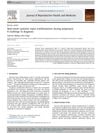Immunological And Some Biological Biomarkers Investigation In Patients With Systemic Lupus Erythematosus
March 2022

TLDR No single biomarker is reliable enough for diagnosing and assessing SLE.
This study investigated biochemical and immunological biomarkers in 35 SLE patients and 35 healthy controls. The results showed significantly higher percentages of discoid rash, malar rash, photosensitivity, anemia, proteinuria, and leukopenia in SLE patients. Hair loss and nervous system involvement were not significantly higher. Anti-dsDNA was the most prevalent characteristic (33%), followed by blood urea (13%), hematuria (12%), and renal involvement (12%). Elevated levels of ANA and Anti-dsDNA were particularly noted. The study concluded that no single biomarker is sensitive or specific enough for SLE diagnosis and assessment.





